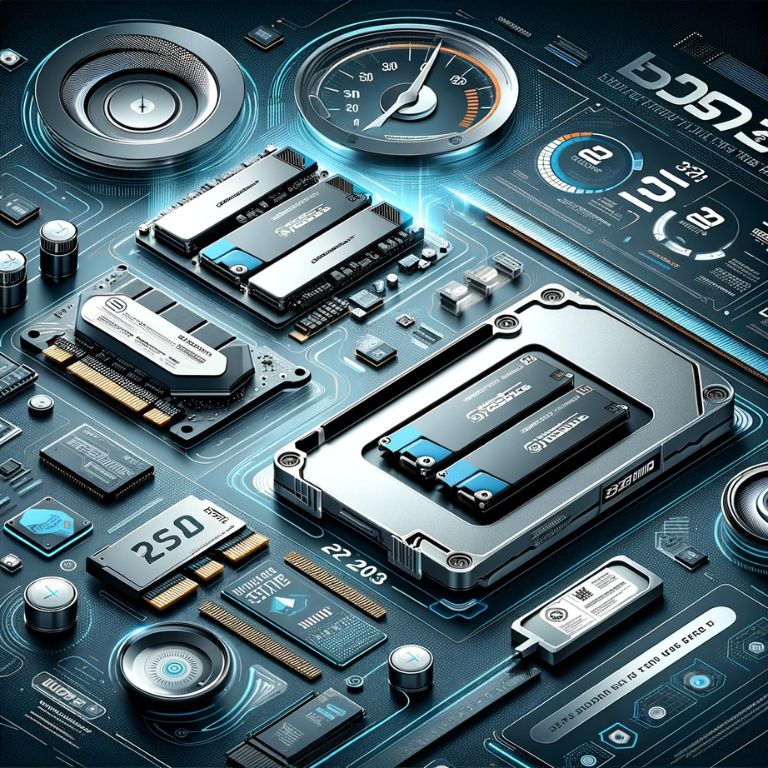The introduction of Solid-State Drives (SSDs) has revolutionized computing, marking a significant shift from the slower, mechanical Hard Disk Drives (HDDs). Unlike HDDs, SSDs lack moving parts, leading to a host of advantages like rapid boot times, faster program responsiveness, and enhanced durability. This technological leap has not only improved general computing experiences but also made SSDs a preferred choice for high-intensity tasks that demand quick data access.
Among the various SSD technologies, PCIe (Peripheral Component Interconnect Express) 4.0 SSDs stand at the forefront, offering double the bandwidth of their PCIe 3.0 predecessors. This advancement in interface technology means not just faster data transfer rates, but also broad compatibility across devices. Whether used in high-end desktops or compact laptops, PCIe 4.0 SSDs deliver unmatched performance, making them a versatile option for a range of users, from casual computing to professional-grade applications that require top-tier speed and efficiency.
Spotlight on Performance: Examining Leading PCIe 4.0 SSDs of 2023
In the realm of PCIe 4.0 SSDs, the WD Black SN850X stands out in 2023 for its exceptional performance, leveraging NVMe technology for rapid read and write speeds. Its advanced PCIe Gen4 x4 interface ensures swift data transfers, making it a dream for gamers and professionals alike. Available in various capacities up to 2TB and equipped with TLC NAND flash, it balances high performance with endurance, ideal for heavy workloads. Its compatibility with both PCIe 4.0 and 3.0 motherboards adds to its appeal, offering versatility across different hardware configurations.
Another significant player is the Corsair MP600 Pro LPX SSD, renowned for its impressive speeds up to 7,000 MB/s read and 6,550 MB/s write, thanks to its NVMe M.2 technology and PCIe 4.0 interface. It’s designed for efficiency and reliability with 3D NAND flash memory and features an advanced cooling system to prevent overheating. Available in sizes ranging from 500GB to 4TB, it suits a wide array of needs, from gaming to professional applications, ensuring quick boot times and responsive system performance. These SSDs represent the forefront of storage technology, setting a benchmark for what users can expect in terms of speed, capacity, and efficiency in the current market.
Comparative Analysis: PCIe 4.0 SSDs vs. Other SSD Technologies
In the SSD arena, PCIe 4.0 models like the WD Black SN850X and Corsair MP600 Pro LPX stand at the forefront, offering superior performance with unprecedented data transfer rates. This advanced technology significantly outperforms older SSDs, particularly in tasks demanding high-speed data processing, such as 3D rendering and gaming. For example, PCIe 4.0 SSDs can achieve read speeds up to 7,000 MB/s, dwarfing the 540 MB/s typically seen in SATA SSDs like the Crucial BX500. This makes them an ideal choice for high-end, performance-intensive applications.
Conversely, SATA SSDs, while not as fast as their PCIe 4.0 counterparts, offer a cost-effective and substantial performance improvement over traditional HDDs. They are well-suited for users with moderate computing needs or those seeking a budget-friendly upgrade. External SSDs, like the Samsung T7 Shield, add the elements of flexibility and portability to the mix, with commendable speeds and robust security features, making them a versatile choice for users who prioritize mobility alongside performance. Ultimately, the decision between PCIe 4.0, SATA, or external SSDs hinges on individual needs, with each type catering to different aspects of computing requirements.
Making the Right Choice: Key Factors to Consider When Selecting an SSD
When selecting an SSD, several key factors need to be considered to ensure you make the best choice for your needs. The form factor is crucial, with 2.5-inch SSDs being universally compatible with most devices, while M.2 SSDs suit ultra-thin laptops and mini PCs. Storage capacity is another vital aspect; capacities range from 128GB to 4TB, and your choice should align with your storage needs—more for extensive file storage and less for basic use. Performance, measured in read and write speeds, is important for tasks requiring quick data access. The interface type also plays a role, with SATA being the older, less expensive option and NVMe offering higher speeds, as seen in PCIe 4.0 SSDs.
Price, while varying, should be balanced with your performance requirements, considering that SSDs have become more affordable over time. The Total Bytes Written (TBW) rating indicates the SSD’s lifespan, with higher ratings signifying a longer-lasting drive. The warranty period can offer peace of mind, reflecting the manufacturer’s confidence in their product. Brand reputation is also worth considering, with well-known brands often being more reliable. Ultimately, your specific needs, whether for general computing, professional tasks, or gaming, should guide your final decision, ensuring that the SSD you choose is perfectly tailored to your requirements.
Conclusion
In conclusion, the realm of PCIe 4.0 SSDs in 2023 presents a compelling landscape for anyone looking to elevate their storage performance. From the unparalleled speeds of leading models like the WD Black SN850X and Corsair MP600 Pro LPX to the cost-effective and versatile options like SATA and external SSDs, there’s a solution for every need and budget. When selecting an SSD, it’s crucial to consider factors such as form factor, capacity, performance, price, and interface, ensuring a choice that aligns perfectly with your specific computing requirements. With the right PCIe 4.0 SSD, users can experience a significant boost in system efficiency, speed, and overall performance, marking a significant step forward in the evolution of data storage technology.




